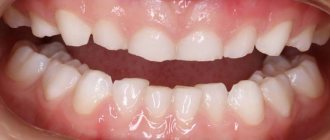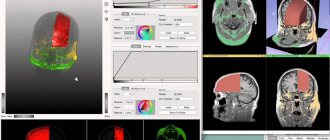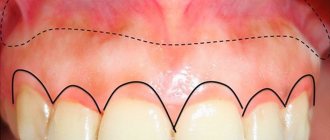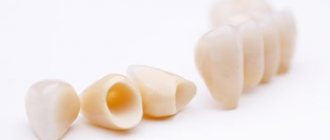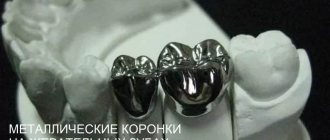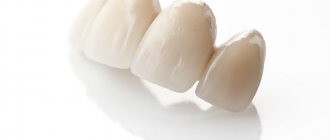Restoration with crowns is one of the options for restoring lost teeth. Installing a crown allows you to equally effectively restore both the functionality of the tooth and its aesthetics. Crowns can be recommended for installation on a tooth even if it has undergone severe destruction due to caries (more than 50%).
Installing crowns is a multi-stage procedure that has its own characteristics, which you can learn about in detail from this article. The material will introduce you to the indications and contraindications for installing dental crowns, tell you about all stages of the treatment process, and the types of crowns that can be used for dental restoration. Also in the article we will talk about whether it hurts to put a crown on a tooth and how you can remove the prosthesis from the tooth if complications arise after prosthetics.
What is preparation or grinding of enamel: a complete list of indications for this procedure
Article navigation
- What is preparation
- What preparation is needed before turning?
- Types of turning
- Peculiarities of turning for different types of prostheses
- Types of ledges when fixing crowns
- Features of the procedure in children
- Will it hurt when turning?
- What to do if there is pain after turning
- Is preparation always necessary?
- How much will the turning cost?
Question to a specialist
To restore “problematic” or missing teeth, we go to an orthopedic dentist who offers various prosthetic options. However, the installation of a veneer, crown, removable dentures or bridge is almost always preceded by dental grinding - and the very mention of it immediately frightens patients. What kind of procedure is this, in what situations is it used, will it hurt, what are the features of the preparation and how the process works in patients of different ages - all this is discussed in today’s material.
What are metal-ceramic dental crowns and bridges made of?
The crown consists of 2 parts – the frame and the covering.
If the crown is metal-ceramic, then the frame is made of metal . In the Health Clinic Istok is a special alloy made in Germany - GIALLOY . The frame is covered with ceramic mass , which is baked in an oven at 400C. The color of the ceramic mass is selected by the doctor in accordance with the color of your teeth or at the request of the patient. The Istok Health Clinic uses ceramics from well-known manufacturers Noritake, Ivoclar, Duceram Plus, e-max Ceram
What is preparation
At its core, the preparation process involves removing part of the hard tissue. This layer, represented by enamel (the outer shell) and dentin (these are the internal tissues), must be equal to the thickness of the prosthesis. Armed with a bur, the doctor cuts off the excess and gives the crown the shape on which the prosthesis will easily and reliably fit. It is important to ensure maximum density and absolute accuracy of its fit. As a rule, the shape of a natural tooth is a cone or cylinder.
Relatively speaking, you will have to “cut off” the amount that is equal to the thickness of the prosthesis. For example, zirconium dioxide will require minimal grinding, but metal-ceramics (after all, there are both ceramics and metal) will require the removal of a thicker layer of living tissue.
Preparation is also carried out during filling, but in this case only inflamed tissues are removed, while healthy ones are preserved. If you need to install a prosthesis, even living tissue will have to be removed.
How painful is the procedure?
The procedure is unpleasant psychologically, but the preparation will be carried out only after the doctor gives you anesthesia - the anesthetic is given even when the grinding is minimal or when the tooth is already “dead”, i.e. it lacks a nerve. This will help you feel absolutely no pain or discomfort in the dentist’s chair. True, some patients, after the effect of anesthesia wears off, note the occurrence of pain reactions. In most cases, pain occurs when a sufficiently large layer of tissue is removed, i.e. before prosthetics with crowns or bridges. Then this is a natural phenomenon that is associated with interference in the living tissues of the body. After all, during the preparation, the doctor used a drill, which heated the tissue and pushed back the gum in order to create a ledge.
The unpleasant sensations should pass soon, but if they continue to bother you for more than 3-5 days and increase in intensity, then be sure to see a doctor. Perhaps the specialist made mistakes when grinding hard tissues, which resulted in an inflammatory process.
What preparation is needed before turning?
In order to secure the future prosthesis well, the prepared crown must be strong, free of plaque and stone, and free of carious lesions (if any, the doctor will, of course, remove them first). Also, before treating the enamel under any prosthesis, it is important to remove soft and hard plaque.
South Korean implant Osstem - 20,000 rub.
Hurry up to sign up for a free consultation and lock in promotional prices.
Call now or request a call
Opening hours: 24 hours a day - seven days a week
Veneers without grinding – is this possible?
The need to prepare teeth before veneering depends to a greater extent on the indications and to a lesser extent on the type of restoration. Lumineers and their Russian analogue ultraneers have a minimum thickness. Therefore, there is no need for grinding before fixing them to the tooth. However, if the teeth are large and require correction of shape and size, preparation is indispensable. Thus, veneers without grinding can be placed for the following indications:
- Need for minor tooth discoloration.
- Elimination of gaps (diastemas) between the front teeth.
- Masking cracks in tooth enamel.
- The need to restore a chipped cutting edge of a front tooth.
The need to correct the shape of the teeth, add volume to them, as well as visually change the angle of their location or align the cutting edge will in any case require preliminary preparation.
Types of turning
The choice of technique depends mainly on the individual clinical picture, as well as on the volume of tissue that needs to be trimmed. There are types that are more extended in time, and there are very fast, safe and pass without the slightest pain. Let's look at all of them that currently exist. But keep in mind that the choice always remains with the attending physician, who will assess the situation and select the most optimal option.
Ultrasonic
This method involves the use of a special apparatus that produces high-frequency vibrations - ultrasonic. And the device itself is called a “scaler” or “scaler”. By the way, it is used to clean enamel from plaque. Also, instead of a scaler, a piezo device can be used - its action is again based on the use of ultrasonic waves, but they are more powerful, which allows it to be used on harder tissues.
During the procedure, the doctor does not touch the enamel with the instrument. Almost no heating occurs. So the risk of damage disappears. As for pain, it may well occur if there is increased sensitivity, so anesthesia will be appropriate. The method makes it possible to dissect only a small volume.
Laser
This is another effective non-contact turning method. The laser acts on the enamel pulsed, but again removing only a very small layer of enamel and inner dentin. By the way, unlike ultrasound, this method is safer, since laser beams have a wound-healing effect. The method is absolutely silent and allows you to quickly achieve the desired result.
Preparation with a drill
This technology involves the use of a good old drill and a diamond (or metal) tip . In fact, this is the most common and optimal turning option. The doctor can choose different speeds of rotation of the bur, but to prevent overheating, water must be supplied. In fact, the process is no different from drilling in the treatment of caries - everything is done in a similar way.
Watch the video at the end of the article - you can get an idea of how the process of preparing a tooth cavity using a drill occurs.
Air abrasive method
This technique is based on the use of a jet of water and a composition with abrasive particles. Using an air-abrasive method, the doctor is able to smoothly grind off the required amount of tissue. The patient does not feel pain. There is almost no heating and vibration. But the technique makes it possible to remove, again, only a minimal amount of tissue.
Chemical turning method
This method involves using exclusively active acids. Penetrating into tissues, special compounds destroy them. The doctor will only have to remove the softened areas and give the crown the necessary shape so that it fits well under the future prosthesis or structure. The procedure is not quick. The method is considered outdated and is not often used.
On a note! Thus, in 99% of cases it is drilling with a drill that is used for prosthetics (and not for the treatment of superficial caries). It is this technology that allows you to remove any amount of tissue in an extremely short time. True, anesthesia will definitely be required (except for those cases when the tooth is already “dead”, that is, without a nerve).
What methods of hard tissue preparation exist?
Despite the development of progressive technologies, today in dental practice doctors carry out the preparation of hard tissues in 99% of all cases using a conventional drill and a diamond tip mounted on it. The procedure is similar to drilling out caries. Less commonly used are laser or ultrasonic methods, as well as air abrasive and chemical methods - all of them are applicable only if it is necessary to remove a minimum amount of tissue, but bur is suitable for any clinical situations.
Peculiarities of turning for different types of prostheses
The type of prosthesis that the patient and the doctor chose to install also determines the preparation technology. Let's consider the features of preparation for each type.
For veneers and lumineers
High-quality turning for veneers allows you to achieve good contact with the artificial plate. The patient will not then feel the pad in his mouth as something foreign. But here it is important to understand why exactly this procedure is necessary:
- for a good fit of the veneer (we will explain later how exactly the turning is done),
- so that the linings do not “stand out”, that is, so that the teeth are not excessively thick,
- so that the row can be leveled using veneers. For example, you will have to grind off the front part of the enamel if one of the elements is crooked and stands out in front. Of course, one overlay will be slightly thinner than the others. But it also has a limit on the minimum thickness - often in such situations the tooth is simply given a new shape.
When installing veneers, the enamel is ground down by the dentist in a special way. First, the doctor treats only the outer, “front” part, followed by the side and cutting surfaces. Very often, vertical and horizontal recesses are made in the front, which are filled with dental glue. All this significantly improves the fixation strength of the pads.
Don't know what type of prosthetics to choose?
We will help in the selection, advise where to read more information and compare types of prosthetics.
Consultation with an orthopedic doctor in Moscow clinics is free! Call now or request a call
Working hours: from 9:00 to 21:00 - seven days a week
It is interesting that to install, for example, thin veneers made of pressed ceramics or lumineers, such strong grinding is often not necessary (especially if your own teeth are straight). It is enough to simply grind the surface using an air abrasive method or a laser to make it a little rougher. This again will allow the lining to be fixed much better and for a longer period.
Under the tabs
Inlays are prosthetics that replace fillings. They are needed in situations where there are still too few indications for a crown, that is, it is too early to place it. Grinding under an inlay is slightly different from preparing for a filling. In order to install the product well, the doctor will only remove all inflamed (carious) tissue, after which he will carefully process the cavity and take impressions, because the inlay is created in the laboratory.
For crowns
A crown helps restore the integrity and beauty of any tooth, and also protects the fragile pulpless unit from destruction and the risk of caries. When preparing a tooth for a crown, it is important to create a special ledge (their types are listed below) - in fact, the future prosthesis will rest on it. Such ledges are most often located under the gum so that the entire tooth can be completely covered, as well as the transition between the crown and living tissues can be hidden.
Let's consider the features of preparation depending on the material of a single prosthesis:
- for cast metal: grinding starts from the sides, remove up to 0.7 mm,
- like plastic: they are more aesthetically pleasing than metal ones; They can be used to cover both front and side teeth. But here the rules are as follows: a plastic prosthesis is made thicker, especially if a metal base is added. So you will have to grind off quite a lot - more than 1.5 mm,
- for metal ceramics: remove up to 2 mm on each side. Such a prosthesis again consists of a combination of materials, so it turns out to be quite thick,
- under porcelain: the dentist gives the unit being processed a cone-shaped or cylindrical shape. Requirements for the ledge: it is made rounded and goes under the gum by 1 mm. Turning – up to 2 mm on each side. When using pressed ceramics - much less, up to 1 mm,
- for zirconium: it is important to obtain an accurate edge of a rounded or shoulder-shaped ledge. As a rule, it grinds down about 0.5-0.7 mm.
It is important to understand that these indicators are completely average. Everything depends not only on the material as a whole, but also on the specific doctor and laboratory equipment.
Complex on 4 OSSTEM implants with delayed loading - from RUB 170,000.
Complex implantation Osstem (South Korea) with delayed loading after 4-6 months.
Guarantee for the doctor’s work - unlimited Call now or order a call
Opening hours: 24 hours a day - seven days a week
This is interesting! Today, it is very common for metal-ceramic crowns to be created with “shoulder mass.” In terms of thickness, they are no different from ordinary ones, but they have a very big advantage: the outer ceramic coating covers the metal underneath, that is, the metal base does not come into contact with living tissues in any way. This eliminates allergic reactions and does not cause blue gums.
Accordingly, if you plan to install a bridge, then grinding down the supporting teeth will be carried out in the same way as when fixing single crowns. Because the bridge consists of them.
For removable dentures
Often, teeth need to be ground down in order to install removable dentures. But only if a reinforced fixation system is used. For example, clasps that are placed inside the crown part, or telescopic crowns that are fixed on top of living teeth.
When splinting
To prevent the patient's teeth from becoming loose (this also happens with advanced periodontal disease or periodontitis), splinting is used. To secure the splint, the enamel is prepared minimally - for this, a small depression is made on the inside of the entire dentition, inside which a special splinting thread is placed. However, in a number of situations it can be simply secured from above, so turning is not required.
Is it painful to grind teeth for crowns?
It is impossible to perform prosthetics without special preparation of teeth, which consists of grinding them down. It is used to level the surface of hard tissues. Many patients find this stage of prosthetics the most unpleasant due to the possible pain of the procedure. The following describes in detail the features of turning.
Necessity of the procedure
No person's teeth are perfectly shaped. The bulges present on them interfere with the production of comfortable crowns. Therefore, the dentist has to prepare or, as people say, grind the teeth.
The preparation stage is necessary to ensure that the manufactured dentures have the correct shape, fit well to the teeth and are firmly attached to them.
The tooth must be prepared by an experienced doctor, who will do this taking into account the thickness of the crown being installed. After all, the manufactured prosthesis should not interfere with talking and chewing food.
Grinding a tooth is often also a therapeutic procedure that removes tissue affected by caries. This stops the progression of the disease
Preparation methods
There are several methods used for preparing (grinding) teeth:
- Ultrasonic
- Using laser
- Chemical
- Tunnel
- Using an air abrasive device
An ultrasound machine performs grinding using waves that do not damage soft tissues or cause overheating of hard tooth tissues.
The amount of heat generated when exposed to ultrasound is minimal. The vibration of the device is low, so cracks do not occur during turning.
The procedure using this method is painless.
Preparation of tooth tissue for subsequent prosthetics using a laser does not cause discomfort or pain.
The advantages of the laser method include speed, noiselessness, safety and the absence of mechanical impact on the nerve endings, which irritates them
The ability of a laser to destroy pathogenic microflora makes additional treatment of the oral cavity with antiseptic solutions unnecessary.
The chemical preparation method takes longer. Special substances soften enamel and dentin. The use of anesthetics is not required, there is no heating of the tooth tissue, and there are no chips or cracks on its surface.
During air-abrasive grinding, sandblasting of hard tooth tissues is performed. Sodium bicarbonate and aluminum oxide serve as abrasives in this case. They are fed through the tip of a special apparatus onto the tooth and grind down the required amount of hard tissue without overheating it and maintaining its sufficient volume. The method is painless.
A turbine unit is used for tunnel turning. The speed of its operation is adjustable. Preparation is carried out with a diamond or metal tip
The classic method is the most painful and unsafe compared to the others.
Along with modern methods, the classic one is still used - grinding the tooth under a crown using a drill. This method is the most painful and unsafe compared to the others.
Unpleasant consequences can be a crack in the enamel or damaged gums.
But during such preparation, the doctor can control the volume of enamel removed, which is an advantage of this method.
It is necessary to choose a preparation method depending on the condition and structural features of the teeth of a particular patient.
He, for his part, before performing prosthetics, must familiarize himself with the technical equipment of the clinic and all the features of the procedure.
Features of teeth grinding
Before starting the preparation, the doctor usually takes an x-ray to clarify the characteristics of the pulp and its reaction to medications, the structure of the tooth, and also determine its condition.
If the nerves of the tooth are killed, then there is no need for anesthesia before preparation using the classical method.
Different types and materials of crowns require different grinding features.
For example, for metal-ceramics, the tooth is ground on all sides, for metal crowns - on the sides, so as not to injure adjacent units.
To install a zirconium crown, the tooth is ground to form a rounded shoulder. If the crown is made of porcelain, the tooth is given a cylindrical or conical shape.
If anesthesia before preparation was performed correctly, the patient does not experience pain during the procedure. It can only occur when a significant layer of dentin is removed or when soft tissue is compressed.
Types of ledges when fixing crowns
If you look at the photo below, it will immediately be clear what ledges are - they are needed to fix the crowns. Such ledges are located under the gum so that the border between the tooth and the prosthesis is hidden.
Accordingly, they also come in different shapes:
- knife-shaped: in fact, in such a situation there is no ledge - the top of the tooth will simply have the shape of a cone. Solid metal crowns are fixed in this way (but today this method is rarely used),
- rounded: used for attaching metal-ceramic crowns, but also not used often,
- shoulder: this is the most popular option, and it is also universal. Such a ledge, although large in thickness, is considered the most aesthetic. It has an angle of approximately 90 degrees.
How long does it take to place a metal-ceramic crown on a tooth?
The duration of treatment depends on the condition of the teeth that we are going to replace. If the tooth is not bothering you and it’s just time to change the metal-ceramic crown, then you will need 2 visits within 5-7 days. If the tooth has not yet been treated, then two visits within 5-7 days are usually sufficient. If the tooth was previously healed, replaced with prosthetics and began to bother you, then you will first have to re-treat it, and only then make and install a new crown. During treatment, the doctor may suggest that you install a temporary crown.
Will it hurt when turning?
The word “grinding” used to sound scary coming from a dentist. Today, the preparation process does not last long and takes place without any discomfort or pain. Before starting the procedure, the doctor will “freeze” the mucous membrane with a special gel, and the patient will not feel the injection with a good local anesthetic at all. Anesthesia is used both in the case of working with living units (in order to “turn off” for a while the nerve that is sensitive to any manipulation) and with “dead” units in which the nerve is absent. After all, turning involves a very painful retraction of the gums.
Taking impressions and making crowns
An impression is taken of the prepared dental units. For this procedure, a special dental plastic mass is used. An impression is necessary to make an exact plaster copy of the patient’s teeth, which will be used to create a permanent structure. For the production of crowns, different types of materials can be used - metal, metal-ceramics or ceramics. The specific type of raw material is selected based on the characteristics of the case and the wishes of the patient.
The production time for dental crowns depends on the type of material chosen. The production process of ceramic and metal-ceramic products takes the longest. If structures made from these materials are chosen for prosthetics, then temporary dental crowns made of plastic are made for the patient during the period of their manufacture. Temporary crowns will help to recreate the aesthetics of the dentition and, in addition, will protect the ground and weakened teeth from the destructive effects of external factors.
What to do if there is pain after turning
It happens that after the anesthetic wears off, the patient experiences unpleasant sensations. They can be either a type of norm or a pathology. Teeth hurt after grinding for the following reasons:
- overheating occurred: the bur rotates at a very high speed, so if the doctor performed the procedure quickly, without stopping, tissue overheating could occur. In this case, the pain will be monotonous, but will go away on its own after a few days or weeks, less often - after a couple of months,
- During preparation, too much was removed: the dentin layer has become thin, the nerve is close, so it is completely normal that the tooth will react with pain. But this is no longer the norm - to prevent such situations from occurring, most doctors still suggest depulping before installing a prosthesis,
- the gums are injured: quite often doctors use special threads and metal plates to push back the mucous membrane. Therefore, slight inflammation and swelling of the gums after the procedure is normal, which disappears on its own within a few days.
- errors when grinding: what to do after the procedure for processing units if the painful symptoms do not disappear even after several days? This is a reason to visit the dentist. It is possible that the nerve was injured or the root split, which led to the development of an inflammatory process. In such a situation, the pain will be acute, tissue swelling is possible (and not only the gums, but even the face). This situation requires a prompt solution.
On a note! The important point is that after turning, a temporary prosthesis is almost always installed - be it a veneer or a plastic crown. After all, after preparing the support, impressions are taken, based on which the dental technician in the laboratory will work on the design of the prosthesis. To save the tooth and restore its aesthetics, the doctor will suggest a temporary replacement.
Stages of treatment: how to prepare, install a crown on a tooth
Below we will analyze in detail each of the stages of prosthetics with crowns, and if you want to get advice directly from a specialist, call and make an appointment with the orthopedic doctors of our dental clinic in St. Petersburg - “Unident”. An initial consultation with an orthopedist at our clinic is provided free of charge!
Inspection and diagnostics
The treatment process begins with a visit to the office of an orthopedic dentist.
The specialist will carefully examine the patient’s oral cavity, identify existing problems, and, if necessary, prescribe a number of additional diagnostic measures. Based on the information collected from the clinical case, the orthopedist will draw up a detailed treatment plan and also offer the patient all possible prosthetic options. A well-designed treatment plan necessarily takes into account not only the installation of a dental crown, but also additional procedures:
- Removal of teeth, restoration and treatment of which is impossible for objective reasons;
- Preliminary treatment of diagnosed diseases of teeth and gums;
- Treatment of tooth canals and their filling (carried out when deciding to depulp a tooth before installing a crown);
- Professional oral hygiene. Sanitation of the oral cavity before prosthetics must be carried out to completely remove hard and soft plaque from the surface of the teeth. The event will allow you to most accurately select the crown to match the color of the patient’s natural tooth enamel, and will also have a positive impact on the quality of treatment.
The preparation of a treatment plan is completed by selecting a specific type of dental crown, after which the total cost of prosthetics is calculated and the timing of its implementation is specified.
Preparatory stage
The duration of the preparatory stage depends on what procedures will need to be carried out before prosthetics to ensure a high-quality and durable result. Below we will consider in detail all the possible stages of preparation for dental prosthetics with crowns.
Depulpation
A few years ago, before installing crowns, teeth were depulped without fail.
But modern orthopedists, if the clinical case allows, strive to keep teeth viable and do without removing the nerve. A tooth with preserved pulp is not deprived of adequate nutrition with minerals and nutrients, and does not acquire increased fragility. Crowns installed on living teeth last longer, but unfortunately, it is not always possible to refuse pulp removal. Most often, the front teeth are depulped, but the chewing dental units are kept alive. They have a fairly large area of the natural crown, in them the distance from the enamel to the pulp chamber is much greater, and therefore the risk of nerve bundle burns when installing a crown will be minimal.
The decision on the advisability of preliminary pulp removal is also made based on the number of roots, which may vary for different teeth. If you plan to install a crown on a single-rooted tooth, the depulpation procedure is mandatory. When treating single-rooted teeth, the risk of pulp burn is too high, and thermal damage to the sensitive nerve bundle is fraught with the occurrence of an inflammatory process under the installed crown. To prevent such negative consequences, single-rooted teeth are depulped, the canal cavities are treated with antiseptic agents and filled with gutta-percha.
Treatment of diseases of teeth and gums
If, during a visual examination of the oral cavity, the doctor discovers caries, signs of the development of an inflammatory process - these conditions must be eliminated before installing crowns.
If the tooth is significantly destroyed by caries, the doctor removes the affected tissue and restores the crown part by installing a durable filling. Pulpitis and periodontitis are treated according to a more complex scheme, which includes treatment of dental canals and filling them. A high-quality and durable filling must be placed on the tooth, otherwise it may fall out, and the installed crown will fall out along with it. In case of severe destruction of a dental unit, its coronal part can be restored in different ways:
- Installing a seal on the pin. A pin is a special structure in the form of a rod, which is inserted into the root canal of the tooth and acts as a reliable support for the filling;
- Stump tab. Inlays for dental restoration are made in a dental laboratory and are installed, like a pin in a canal, but are also fixed in the crown of the tooth.
If a tooth is severely damaged, it is recommended to restore it with an inlay, which is considered more reliable and durable than a conventional filling or installation of a filling on a pin.
Preparatory activities are completed with professional oral hygiene. Sanitation is necessary for the complete and high-quality elimination of dental plaque, which is a favorable environment for the proliferation of pathogenic organisms, in addition, the procedure will allow you to accurately select the color of the crown for installation so that it matches as closely as possible the shade of the natural enamel of the patient’s teeth.
Preparation
Preparation or grinding of teeth is a procedure that the doctor performs before taking impressions.
During the preparation, the tooth enamel will be ground down to the thickness of the future crown. During the grinding process, a drill is used: with its help, the tooth is given a certain shape that can provide the most durable fixation to the installed crown. If living, non-pulp teeth are subjected to preparation, the procedure can be very unpleasant and painful for the patient, and therefore local anesthesia is used before it is performed. The thickness of the enamel removal will depend on the type of crown that will be subsequently placed on the prepared tooth. A maximum of natural tissue is removed from the tooth to install ceramic and metal-ceramic crowns; the enamel is ground down to a minimum before prosthetics with cast crowns.
After the tooth has been prepared, a stump remains, from which the doctor will take impressions to produce crowns.
Laboratory stage
An impression is taken from the ground teeth. To obtain a high-quality, anatomically accurate impression of teeth, a specialized highly elastic mass is used to produce a crown. Using impressions, a dental technician in the laboratory will make a plaster model of the patient’s teeth, which will be used to make crowns for further installation. Dental crowns can be made from a variety of materials - alloys of precious and non-precious metals, ceramics, zirconium dioxide, metal ceramics. The type of crowns for installation is selected based on the characteristics of a specific clinical situation, the patient’s preferences, his wishes for the level of aesthetics, as well as financial capabilities.
The timing of its production will depend on the type of raw material from which the crown will be made. The company has been producing crowns made of ceramics and metal-ceramics for a long time. So that the patient does not have to walk with an unsightly stump during the entire period of crown production, a temporary immediate prosthesis is placed on it for this period. Temporary crowns are made of plastic, and their installation allows you to relieve the patient from psychological discomfort, as well as protect prepared and vulnerable teeth from the action of pathogenic microflora and harmful environmental factors.
Fitting and installation of dental crowns
When the dental technician makes the crown frame, the patient will be invited to the clinic for fitting.
During fitting of the frame part of the crown, the tightness of its fit to the surface of the tooth stump is assessed. If the fit is insufficient, food debris and bacteria will get under the installed crown, and all this can lead to the onset of an inflammatory process. If during fitting the crown fits perfectly on the stump, the frame is sent to the laboratory, where it will be covered with ceramic mass. The finished crown is tried on a second time and during the second fitting it will be fixed with temporary cement mortar. A second check is required to assess the quality of contact between the prosthesis and the opposing teeth, and if it goes well, the crown will be installed on the tooth using permanent cement. The process of permanently installing a crown on a tooth takes place according to the scheme described below:
- The inside of the crown is covered with a layer of cementing solution, after which the crown is put on the tooth;
- A tooth with a crown is exposed to light, which accelerates the hardening process of the cement mortar;
- All excess cement mixture is carefully removed, since it is a rather caustic substance and, if it comes into contact with soft tissue, can cause severe burns.
The treatment ends with a detailed consultation from the orthodontist on the care of the prosthesis and oral cavity after prosthetics. Compliance with the specialist’s recommendations guarantees the absence of negative side reactions and complications after crown installation.
Is preparation always necessary?
The good news is that no, not always. If a minor correction of the defect is expected - for example, with the help of artistic restoration, then the dentist will simply limit himself to grinding. This will enhance the adhesion of the glue and material.
Dentists do not always treat enamel before fixing veneers[ii] - this has already been discussed earlier. No preparation is required when installing classic removable dentures, which are fixed to the supporting teeth using plastic or metal hooks. Teeth are also not injured when defects are replaced with implants - these are artificial analogues of roots, the installation of which in no way affects the position and condition of neighboring teeth. Even when you subsequently need to place a crown on top of the implant.
Important! It is necessary to understand that preparation will be required only if there is “something left” of the tooth. That is, if the top is destroyed at the root, there will be nothing to grind. In such situations, you need to build up the root - for example, using a pin or stump tab. And then fix the single prosthesis from above.
However, you still cannot do without the turning stage when installing a classic crown. Science has not yet come up with other ways to reliably fix such prostheses.
Purposes of preparation
In the process of turning teeth for crowns, the following is created:
- Prosthetic space for construction;
- The support stump is of a shape that will provide conditions for the application and fixation of the prosthesis;
- Correct relationship between the edge of the artificial crown and the periodontium.
Each of the above points is very important in the process of functioning of the structure. Prosthetic space is necessary to prevent overbite. The correct shape of the ground tooth will ensure the longest and most durable cementation. And it is worth mentioning separately about the correct interaction with the periodontium.
How much will the turning cost?
The cost of dental preparation differs depending on the economic policy of the clinic.
But in most situations, no one highlights it as a separate service - it is simply included in the overall price of prosthetics. That is, for example, if installing a ceramic crown costs 20 thousand rubles, this implies that the price also includes preparation. But sometimes you will have to pay an additional 500 to 2000 rubles for a temporary crown, which is placed on a ground tooth to protect it. Not all clinics operate on an all-inclusive basis, so you definitely need to clarify what exactly is included in the price of prosthetics. Belenchikov A. A., Biragova A. K., Epkhiev A. A. Assessment of changes in the microstructure of hard dental tissues after preparation with various types of burs. Journal of health and education in the 21st century, 2022. [ii] Vedernikova L. V., Zholudev S. E. Planning the aesthetics of ceramic veneers without preliminary tooth preparation, 2013.
What is a dental crown?
A dental crown is a non-removable dental prosthesis in the form of a single element, a kind of “cap”, which is made from impressions in a dental laboratory and then attached to the tooth. In this way, the crown, or visible part of the tooth is replaced if it is severely damaged, missing or has a serious aesthetic defect. Crowns will be required in order to fix a bridge or clasp prosthesis on supporting teeth, which may be completely healthy. You can “crown” not only a damaged natural tooth, but also, in the case of its complete absence, a dental implant.
The question of installing a crown usually arises if the crown part of the tooth is destroyed by more than 70%. In this case, you can forget about filling or microprosthetics with an inlay. They will not provide optimal redistribution of the chewing load. In the future, this threatens that improper pressure on the tooth will lead to its splitting and inevitable subsequent removal. Therefore, the choice between a filling, an inlay and a crown should be based solely on the indications.
What teeth are crowns placed on?
As a rule, crowns are installed on the lower and upper teeth without any fundamental differences; only the part that matters is the anterior or chewing one. For the smile zone, aesthetics is an important criterion for the quality of prosthetics. The prosthesis must be absolutely identical to natural teeth. In such cases, a crown made of solid ceramics or based on zirconium dioxide is placed. The main criterion for choosing structures for the chewing group is the strength possessed by metal, metal-ceramic and zirconium crowns. The crown on the wisdom tooth is fixed if the figure eight is in the correct position and is involved in chewing or is necessary to secure the clasp prosthesis.
Indications for installation of dental crowns
- Carious lesions in more than 50% of tissues;
- Aesthetic problems - large chips and cracks, discoloration;
- Fracture of the coronal part;
- Pathological abrasion of enamel.
Removing dental crowns: indications and features of the process
Removing dental crowns is a procedure that becomes necessary if certain complications arise after installing the prosthesis. Removal of the structure may be required in situations:
1. Poor quality preparation for dental crown prosthetics. If the tooth canals are poorly cleaned and poorly sealed, then an inflammatory process may begin to actively develop in them. If such a process occurs, the crown will need to be removed and the tooth treated or removed.
2. Inaccuracies in the manufacture of a crown on a tooth, in which the installed structure will overestimate the bite and not fit tightly to the tooth.
Crowns are also removed for planned replacement. High-quality structures can last up to 10 years or more, but after that the crown will be replaced with a new orthopedic product. Crown removal may be uncomfortable for the patient, so it is usually performed using local anesthesia. To remove the structure, it is sawed with a bur, removed, and those medical manipulations that are necessary for a particular case are performed.
We hope the material helped you learn all the important nuances of installing crowns on your teeth, and you can always get more detailed advice on prosthetics from the dentist at our Vanstom clinic in Moscow! To make an appointment, just call us!
Trying and installing a crown
At the stage of manufacturing crowns, a preliminary fitting is required, which will allow us to evaluate the accuracy of manufacturing structures for the patient’s teeth and the tightness of the product. If all is well, the crown manufacturing process ends, the finished prosthesis is handed over to the orthopedist and the patient is invited to the specialist’s office for preliminary temporary fixation of the structure.
Temporary fixation of the crown is an event necessary to check the quality of the crown installation. The specialist will also evaluate the tightness of the prosthesis to the ground teeth and make sure that the closure of the crown with the opposing teeth occurs correctly. When temporarily fixing dental crowns, permanent cement is not used, and this allows you to quickly remove the structure if any defects are detected during its operation.
The assessment of the quality and convenience of the crown during temporary fixation is carried out within a certain period of time, which on average is 2-4 weeks. If no defects are identified during this time period and the patient does not complain of discomfort, the crown is fixed with heavy-duty permanent cement. This completes the prosthetic process.
Calculate the cost of treatment by taking a short test in 20 seconds!
Do not delay your treatment, because in this matter time plays against us.

